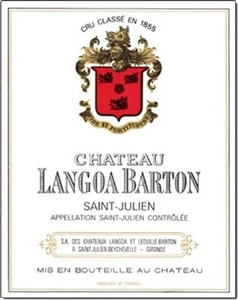| Region | |
|---|---|
| Subregion | France > Bordeaux > Left Bank > St Julien |
| Colour | Red |
| Type | Still |
Léoville Barton's smaller (18 hectares) sister Chateau. Grape varieties, viticulture and vinification are similar to those of Léoville. Quality is often very similar too. Classic claret is produced here with real Cabernet Sauvignon "grip" and class. There are currently 17 hectares in production, with an average vine age of 35 years.

Tasted blind. Deep ruby purple colour. Exotic baking spices on the nose together with brambly fruit. This fleshy richness continues on the palate. There is some restraint offered by grippy tannins but the fruit and plush oak come together to offer a very generous style. Good power without excess.
Drink 2024 – 2035
Lots of crushed blackcurrants and chocolate on the nose, following through to a medium to full body with soft, friendly tannins that are caressing and beautiful. Drinkable now, but better after 2022.
The 2017 Langoa Barton has a medium to deep garnet-purple color. It sashays out with scents of fragrant black cherries and redcurrant jelly, followed by cassis, tilled soil, bay leaves, and hints of fallen leaves. Light to medium-bodied, the palate is bright and energetic, featuring grainy tannins and bold freshness, finishing long and savory.
As is often the case with 2017 St Julien, you find sculpted fruit with precision and spice that will be ready just a little earlier than the vintages on either side of it - think four or five years from now ito fully soften out the tannins. Plenty of depth of flavour, finessed raspberry fruits with rose stems, liqourice, cocoa bean, smoked earth. Austere but enjoyable, and reflective of the fact that St Julien was lucky in this vintage because it was far less impacted by frost than many other parts of Bordeaux. 70% new oak. Technical director François Brehant, consultant Eric Boissenot.
Healthy cherry red. Inviting and elegant dark-fruit aroma with just a light char. Here, after several left-bank wines that lacked enough fruit depth in the middle, is one that has weight and depth on the mid palate that gives a rounded, fresh and complete wine. Succulent, juicy and well-structured for the longer term but still elegant. Drink 2027-2040.
Ripe black cherry the nose is sweet depth of flavour the palate starts with a rich mix of cassis and black cherry. There is balance with freshness under the generosity the finish has rich mix of ripe fruit. 2026-39
A lovely Langoa with a come hither nose and a succulent palate, this is a juicy, medium-weight, civilised wine with some cranberry and cherry notes and a smooth, cultured, seemingly forward finish. This is a typical Langoa, which shows the generosity of this property and its philosophy and I think it will drink very well young but baffle people with its ability to hold.
This is very solid and tannic with a beautiful core of blueberries, blackcurrants and other blue fruits. Crushed stones, to boot. Full body and a flavorful finish. Serious for the vintage.
The 2017 Langoa Barton is medium to deep garnet-purple colored and features wonderfully pure scents of crushed blackcurrants, wild blueberries and black raspberries plus wafts of underbrush, dark chocolate and violets. Medium to full-bodied, the palate is laden with seductive black and blue fruits, framed by grainy tannins and just enough freshness, finishing long and perfumed.Drink: 2022-2042
There is no doubt that this offers a good expression of the appellation in the medium to long term, but there's a slightly wider gap between Léoville and Langoa this year - the first time I've felt that in several years, and perhaps a reflection of the slightly cooler terroir here. It's impressively structured and well held together, with black fruits which aren't as concentrated as the estate has displayed in the previous two vintages, but it displays an innate St-Julien elegance.
Drinking Window 2025 - 2038